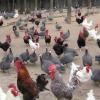
Domestic animal breeds as genetic resources are part of the Earth’s biological diversity, which means they play an important role in preserving the biological balance in human food resources. Therefore, preserving them is a global issue for the whole mankind. In animal husbandry (and plant breeding) the number of breeds is continually decreasing, and hence, it is assumed that the variability is declining. Nowadays, few specialized poultry populations provide the basis of commercial breeding programs. This limits the possibilities of breed elevation.
Unique, rare genotypes can become more important as we can see in the development of European poultry breeding. Besides the cheap bulk goods there is a growing demand for poultry products providing special quality produced by special technologies (free range, ecological, organic, etc.). Nowadays the quality control of the premium products, product lines is required. The methods elaborated in our institute (HáGK) contribute to set up a complex population identification and traceability system for poultry products considering the market demands of the 21st century.
Of course, the qualitative production – providing special goods – needs radically different technology, therefore basically other genotypes. Since these technologies are significantly affected by the environment, the native breeds can adapt the easiest. The unique combinations of genes making up a specific genotype, that might constitute adaptation to local environment or other potentially beneficial traits.
Traditionally used local breeds are excluded from competition and hardly can survive even in gene banks in spite of their unique values. Since the storage capacity of the gene banks is limited, it matters, how many and what samples of a breed should be preserved.
The aim of this work was to characterize our poultry gene bank with molecular genetic markers for population identification and traceability, and to improve the efficiency of in vitro gene conservation.
We genotyped the Hungarian indigenous poultry breeds (chicken: Yellow, White, Speckled and Partridge colour Hungarian, Speckled, White and Black Transylvanian Naked Neck; turkey: Copper and Bronze Hungarian; goose: Frizzled Hungarian and Hungarian; duck: White and Wild colour Hungarian; guinea fowl: Hungarian landrace) with 13-29 microsatellite markers, depending on the species. Marker combinations were set up depending on the efficiency of primers, fluorescence labelling and amplified allele sizes, and then multiplex PCR reaction conditions were determined.
The Hungarian breeds were compared to different populations (commercial stocks, or different breeds of the given species from Hungary), and 3-6 markers were determined which are unique to the given breed. A criterion of the chosen markers was to be as much specific as possible and fixed in the given population. This can help us in population identification and traceability even in their products.
Nóra Bodzsár, Nikoletta Sztán, Erika Meleg Edviné and András Hidas